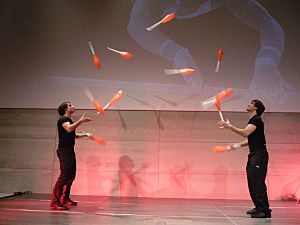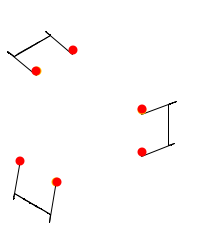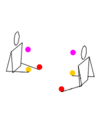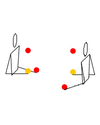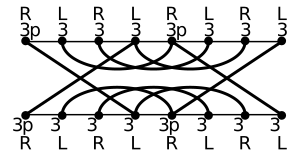Passing (juggling) facts for kids
Passing is a cool way to juggle with friends! It means you throw and catch juggling props like balls, rings, or clubs with one or more other people. It's a fun team activity that needs good timing and practice.
Contents
What is Juggling Passing?
Passing usually involves two or more people juggling together. While you can pass with just three props, it's most common to see jugglers passing six objects. This is often done with two people, each starting with three props. Jugglers usually stand facing each other, but they can also stand side-by-side or even back-to-back.
Choosing Your Juggling Props
Different juggling props work best for passing:
- Clubs: These are the most popular choice for passing. Clubs are easy to catch because they have a larger handle. You can also do many cool tricks with them, and they are easy for an audience to see.
- Rings: Jugglers sometimes choose rings when they are passing many objects at once. Rings are light, and they are less likely to crash into each other in the air.
- Balls: Balls are not used as often for passing, except by beginners. They are also used for a special type of passing called bounce juggling passing, where the balls bounce off the ground.
How Do Jugglers Pass?
The way you pass depends on the prop you are using and how the jugglers are standing. The most common way is when two jugglers face each other, each juggling three props. This creates a pattern that looks like a rectangle or a box.
- Self Throws: These are throws you make to yourself, keeping the prop in your own juggling pattern.
- Pass Throws: These are throws you make to the other person.
Usually, you throw a pass from your right hand, and the other juggler catches it with their left hand. A common rhythm for passing is called a "two-count." This means you throw one prop to yourself from your right hand, and then the next prop from your right hand goes to your partner. This is sometimes called "every others."
Beginners often start by passing balls, then move on to rings, and finally to clubs. Club passing is very popular because it allows for more tricks and looks great to watch!
Understanding Passing Patterns
A passing pattern is a repeated series of throws and catches. A basic example is the standard six-club passing pattern between two jugglers using a two-count rhythm. Patterns can be simple, like two jugglers passing three clubs (called 'running three'). They can also be very complex, with many jugglers passing lots of clubs in fancy ways.
A trick is different from a pattern. A trick is a special throw or catch that changes the usual pattern. For example, throwing a single prop very high to your partner at just the right moment is a trick.
Common 6-Club Passing Patterns
The main difference in patterns is how often you pass a prop instead of throwing it to yourself.
- Four-count (or "Every Others"): This is one of the most basic passing patterns. In four-count, every fourth throw you make (which is every second throw from your right hand) is a pass to your partner.
- Three-count (or "Waltz"): In this pattern, every third throw is a pass. This means the passing throw switches between your left and right hand.
- Two-count (or "Solids" or "Everies"): This is a fast-paced pattern. Every throw from your right hand is a pass to your partner. With practice, jugglers can keep this pattern going for a long time. The pattern goes: pass, self throw, pass, self throw, and so on.
- One-count (or "Ultimates" or "Thunder Shower"): This is the fastest pattern. Every single throw you make is a pass to your partner! It's like two separate juggling patterns happening at once. This pattern is very quick and needs a lot of skill with both hands.
Juggling Tricks and Variations
Jugglers can add many tricks to their passing patterns. These include:
- Throwing props in different ways, like under the leg or behind the back.
- Making props spin the wrong way or not spin at all.
- Throwing props extra high, which means the other person has to adjust their timing.
Club passing can also include throws without a flip (called "floaters") or throws with a double or triple flip (called "spinners"). It's also possible to pass with more than two people, and with more than three clubs each!
How to Start a Passing Pattern
There are a few common ways to begin a passing pattern:
- Slow Start: Both jugglers begin by throwing props to themselves, as if they had just received a pass. For example, in a four-count pattern, each juggler would make four self-throws before making their first pass. This is good for beginners.
- Fast Start: Both jugglers begin by throwing a pass right away. This is more popular among experienced jugglers.
- Asynchronous Start: One juggler throws a pass, while the other juggler waits or throws to themselves first. This happens when one juggler starts with more objects, like when two jugglers are passing seven objects.
Juggling Rhythms
The rhythm of passing can change how it feels and looks:
- Even Rhythm: This is the usual rhythm, where each hand throws with equal time between throws.
- Galloped Rhythm: In this rhythm, your left hand throws a little bit after your right hand has thrown.
- Synchronous Rhythm: Both of your hands throw at the exact same time.
Avoiding Collisions
A collision happens when two or more props hit each other in the air. Usually, this means the pattern breaks. Jugglers have ways to avoid collisions. For example, in the six-club "Ultimates" pattern, throwing the clubs "from in to out" can help prevent them from crashing. Another way is for one person to throw their props a bit wider than usual.
World Records in Passing
Just like with solo juggling, there are world records for passing! The rules usually say that jugglers must use the "two-count" passing pattern. To count as a successful attempt, the number of successful catches must be four times the number of props.
Here are some cool passing records:
- 12 clubs: Daniel Ledel and Dominik Harant caught 77 passes in 2012.
- 10 clubs: Daniel Ledel and Dominik Harant caught 682 passes in 2011.
There are also records for three-person club passing with videos available online.


